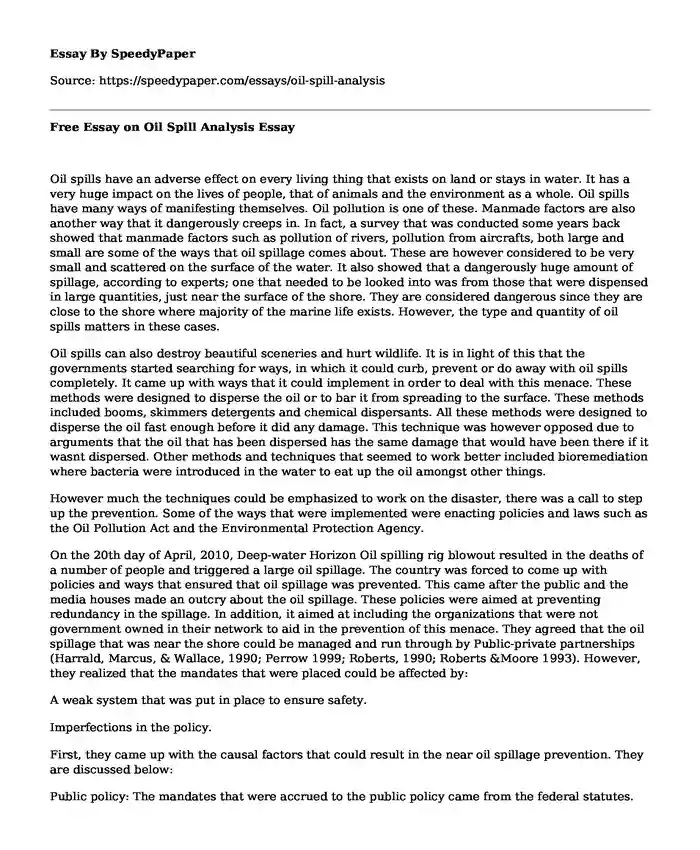Oil spills have an adverse effect on every living thing that exists on land or stays in water. It has a very huge impact on the lives of people, that of animals and the environment as a whole. Oil spills have many ways of manifesting themselves. Oil pollution is one of these. Manmade factors are also another way that it dangerously creeps in. In fact, a survey that was conducted some years back showed that manmade factors such as pollution of rivers, pollution from aircrafts, both large and small are some of the ways that oil spillage comes about. These are however considered to be very small and scattered on the surface of the water. It also showed that a dangerously huge amount of spillage, according to experts; one that needed to be looked into was from those that were dispensed in large quantities, just near the surface of the shore. They are considered dangerous since they are close to the shore where majority of the marine life exists. However, the type and quantity of oil spills matters in these cases.
Oil spills can also destroy beautiful sceneries and hurt wildlife. It is in light of this that the governments started searching for ways, in which it could curb, prevent or do away with oil spills completely. It came up with ways that it could implement in order to deal with this menace. These methods were designed to disperse the oil or to bar it from spreading to the surface. These methods included booms, skimmers detergents and chemical dispersants. All these methods were designed to disperse the oil fast enough before it did any damage. This technique was however opposed due to arguments that the oil that has been dispersed has the same damage that would have been there if it wasnt dispersed. Other methods and techniques that seemed to work better included bioremediation where bacteria were introduced in the water to eat up the oil amongst other things.
However much the techniques could be emphasized to work on the disaster, there was a call to step up the prevention. Some of the ways that were implemented were enacting policies and laws such as the Oil Pollution Act and the Environmental Protection Agency.
On the 20th day of April, 2010, Deep-water Horizon Oil spilling rig blowout resulted in the deaths of a number of people and triggered a large oil spillage. The country was forced to come up with policies and ways that ensured that oil spillage was prevented. This came after the public and the media houses made an outcry about the oil spillage. These policies were aimed at preventing redundancy in the spillage. In addition, it aimed at including the organizations that were not government owned in their network to aid in the prevention of this menace. They agreed that the oil spillage that was near the shore could be managed and run through by Public-private partnerships (Harrald, Marcus, & Wallace, 1990; Perrow 1999; Roberts, 1990; Roberts &Moore 1993). However, they realized that the mandates that were placed could be affected by:
A weak system that was put in place to ensure safety.
Imperfections in the policy.
First, they came up with the causal factors that could result in the near oil spillage prevention. They are discussed below:
Public policy: The mandates that were accrued to the public policy came from the federal statutes. The Oil Pollution Act was the first of this kind. It was enacted in 1924 (33 U.S.C. 401).it gave powers to the Corps of Engineers to deal and regulate the spillage of the oil near the shore. This act also made it unlawful to spill the oil into the waters that the state considered navigable. In 1966, the act was extended to include all waters that were inland. Furthermore, it was extended to include prohibition of dumping harmful waste into the waters. This law was known as The Water Quality Improvement act.
Regulatory Authority: This was started as the government realized that there was need to take the lead role in regulation of the law as there was a clash between the private institutions self-interests and the choice of the public. The need to bring together inter organizational adherence to come together and see to the safety of the waters was realized. Agencies were charged with making sure that some of the regulations that were outlined in the act were looked into. This was because some of the self-interests that the private organizations had could lead to deviant behavior if they were left to be exercised without proper regulation.
Integrity: In this context, integrity is used to mean the self-drive to adhere to the laws that have been put in place. Here, the organizations are supposed to come up with ways that they will ensure that they do what is expected of them by law (Verhezen, 2008).
In conclusion, the causal factors that have been discussed here have been used to discuss and extend the policies that have been put in place for the oil spillage prevention. They are therefore of great importance.
References
Agranoff, R., & McGuire, M. (2003). Collaborative public management: New strategies for local governments.
Savas, E. (2000). Privatization and public partnerships.
Encyclopedia of Environment and Society.
Cite this page
Free Essay on Oil Spill Analysis. (2019, May 23). Retrieved from https://speedypaper.com/essays/oil-spill-analysis
Request Removal
If you are the original author of this essay and no longer wish to have it published on the SpeedyPaper website, please click below to request its removal:
- Converting Passion into Inspiration, Free Essay in Writing
- Youth and Society, Free Essay with an Article Summary
- Free Essay Describing Perspective of Restaurant Owners in Lebanon
- HRM Essay Example on Hiring Managers to Chinese Office
- Free Essay Describing the Urinary Tract Infection Case
- Free Essay Sample about Challenges of Workplace Communication
- Theories of Development. Paper Example
Popular categories





